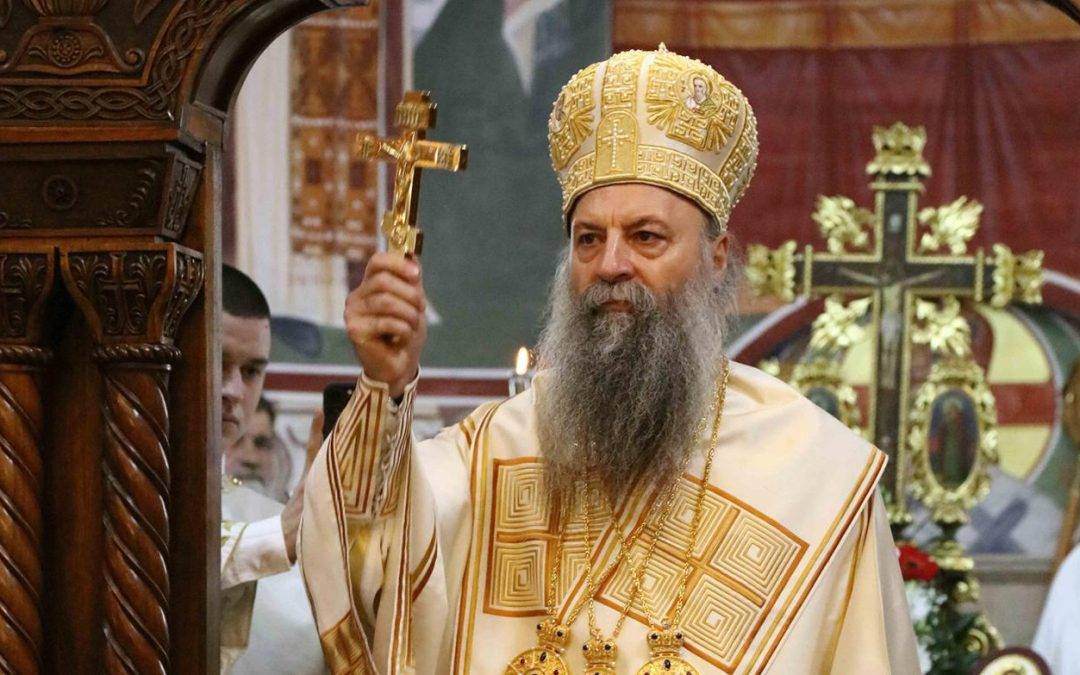
Retrospective for the wider context of media attacks on Patriarch Porfirio
It is not remembered that some epistle of the Serbian Orthodox Church (which is often mistakenly called the Patriarch's, although he does not sign it alone, but with all the bishops of the Serbian Orthodox Church) experienced so many highly critical observations in a part of the Serbian media space that, conditionally speaking, could be characterized as left-liberal-pro-Western, as is the case with this year's Easter message. Therefore, the topic of that criticism deserves an analytical review, which would first include a concise retrospective of the media image of the Church formed in these areas in the last few decades. Such an introductory overview will help us to more clearly perceive the broader context and some important laws, and then to apostrophize what was kept silent in the May media attacks directed at Patriarch Porfirio.
*
A little less than a decade ago, a collection was published called Press and Church 1960 - 1990, authored by Dušan N. Petrović, former rector of the Karlovac Seminary. Prota Dušan, like a diligent bee, collected in that collection selected articles about the Church that appeared in the press during the self-governing socialism. In this sense, the book is an important historical testimony of what media reports were like about the episcopate, clergy and monasticism of the Serbian Orthodox Church during the various phases of Titoism. Reading the titles of articles such as "Politicization of Orthodoxy", "Political Incense", "The Church in a Religious Framework", "Politicism in the Religious Press"... , we can get a sense of déjà vu, considering the titles and subtitles of articles about the Patriarch in the last month in to that part of the Serbian media space that in our time represents Nova S - N1 - Danas - Vreme. Titles and subtitles such as "Porfiry misused both Jesus Christ and Easter", "Patriarch in the campaign", "Porfiry's Easter message: Let's be better people, Serbs are always victims", "No one should know when the president of the republic goes to church", " A blessing before the trip to New York, and it's not 1389" as if they came out of Prote Petrović's collection, and not from the current one. It goes without saying that the media workers who today write extremely critically about the Patriarch are not guided by Marxist ideology like the "comrade" journalists from the aforementioned collection, but, judging by the titles, some kinship in spirit with Marxists is obvious.
At the very beginning of this review, we should briefly recall the fact that from the Second World War until today, three completely different models of the relationship between the Church and the State have been applied in Serbia, on which the media image of the Serbian Orthodox Church (that is, its dignitaries, priests and believers) mainly depended ). In the multi-decade period of Titoism, which was marked by the state model of persecution of the Church (which, due to the open animosity towards the faithful people, could hardly be called even a fundamentalist form of secularism), nothing good could be seen or heard about the Serbian Orthodox Church in the southern media. Church. The only church figures who were portrayed in a very affirmative tone were the members of the so-called of the "progressive" part of the clergy, whose members were public promoters and sympathizers of the state system at that time (some were also members of the Communist Party of Yugoslavia) and believed that it was possible to combine the Cross and the Pentacle. The extremely antagonistic attitude of the communist state apparatus towards the Church, with its expressed and undisguised intolerance towards its leading figures, had a clear reflection at that time in all the media, all but one of which were state-owned and under the strict control of an extremely authoritarian (in one phase and totalitarian) regime.
With the introduction of multi-party systems after the formal (collapse) of communism, the media image in these areas becomes healthier, and privately owned mass media also appear. At the same time, the relationship of the new state government towards the Church begins to slowly change and develops into a typically secular model without benevolence, but with tolerance and without pronounced intolerance. This is also reflected in the domain of the state-owned media, where systematic primitive attacks on church dignitaries and clergy cease.
At the beginning of the nineties of the last century, a new development occurred - for the first time in the post-war history of Serbia, the Serbian Orthodox Church managed to get as much space as possible on the state media for religious content of an educational nature. The first participant in those educational religious programs on state television was Bishop Dr. Irinej (Bulović), in the series "Bukvar Pravoslavlja". Historically speaking, that was the first breakthrough of the Orthodox word on the post-war state media in Serbia (remember, today's patriarch Porfirije (Perić), a monk from Kovilja, participated in the same series). In terms of expressing any critical position, however, the Serbian Church at that time in the state media - which was still completely controlled by the ruling regime, which was to a large extent the successor of the previous, communist one, at least in terms of symbols and values - was not had no space. The church dignitaries of that time expressed their critical observations either in the church's printed newsletters or in the mass media that were opposed - the most impressive example in this regard was, certainly, the anthology performance of the blessed bishop Dr. Atanasi (Jevtić) at Studio B.
The year 2000 marks a turning point in the relations between the state and the Church, and therefore in the media image of church life in the state media. Then there is the final fall of the authoritarian regime that inherited a certain ideological connection with the communists. Church and state in the Republic of Serbia still remain separated after that event, but with one important difference - they are rapidly developing the principle of mutual cooperation for the general benefit of the people, which is also reflected in the media. All of us who were witnesses of that time well remember the joyous shock when we saw on state television a scene completely unimaginable for the previous period: that the president of our country attends and receives communion at the Holy Liturgy. At the same time, Dr. Vojislav Koštunica made a huge contribution in the field of establishing centuries-old Serbian-Christian symbols on state signs - his legacy is the return of the Cross, the crown and the double-headed eagle to the Serbian flag, as well as the return of the hymn "God's Justice". In this way, the communist legacy was finally canceled in the domain of state symbols (though not completely, due to the continued existence of the so-called House of Flowers), and President Vojislav Koštunica went down in history as the first authentically Serbian statesman after the Second World War. An equally important historical contribution to the development of relations between the state and the Church was made by Prime Minister Dr. Zoran Đinđić. Let us remind you that Dr. Đinđić was the man most responsible for the return of religious education to schools (which he did in short order, despite the very strong opposition of a part of intellectuals and politicians from the left). At the same time, Prime Minister Đinđić gave very clear, concrete and open support to the collection of funds for the Church of St. Sava - this is amply evidenced by his speech at the donor's dinner in which he spoke about the "restoration of the national spirit" and that "with God's help" we will complete the construction Temple.
Those four things - the flag, the anthem, religious instruction and help in the construction of the St. Sava Temple - were to this day the symbol of a new chapter in the relations between the state and the Church when it comes to Serbia. Thanks to the aforementioned two Serbian intellectuals-statesmen, the era of cooperation between the state and the Church in fields of wider importance began. All this was clearly reflected in the media sphere - on the state media, church dignitaries appear more and more often and express their position on various issues more and more freely, while the Serbian Orthodox Church itself is presented in an extremely affirmative way.
On this occasion, we will not go into the pro et contra argumentation to what extent the Church and the state should be in close relations in general, nor do we have enough space for that in this review. In principle, in a purely legal and social sense, cooperation between these two separate entities is desirable if it contributes to the spiritual and material well-being of citizens. At the same time, it is important to emphasize that this cooperation is not unconditional, on the contrary. It was the post-October 5 period that showed that there are cases in which the Church cannot stand aside, despite the fact that its relations with the state are excellent. A classic example is the broad public debate on the topic of biometric identification systems, launched in 2004, in which the prominent bishops of the Serbian Orthodox Church (primarily the blessed bishops Hrizostom (Stolić) and Amfilohije (Radović)) played a very important role. In short, at that time, prominent figures of the church hierarchy opposed an intrusive state project, despite the fact that only a few years earlier, a historic chapter of cooperation in the relations between the Church and the state had been opened. Thanks to the position of the episcopate of the Serbian Orthodox Church (which, let's recall, was formed on the basis of expert symposia and independent studies), in early 2007 the state adopted a compromise solution that is in force to this day. With this event, however, we come to a very interesting phenomenon in the post-communist media space of Serbia, at least when it comes to the media image of the Church. Namely, during this public debate, the then most influential civil, liberal media and leader of the so-called "independent" journalism - television B92 - in the way of reporting, the selection of news, the blog section of the site, and even the way of moderating topics on the forum of its site (which I talked about two decades published a text entitled "Forum against the truth"), unequivocally supported the state project instead of the civil initiative that was dominantly supported by the Serbian Orthodox Church with its authority. In a purely media sense, this phenomenon is a classic example of how, in the post-communist Serbian society, the media coverage of the so-called "independent" (and in fact liberal-pro-Western) media sector about the activities of the Church depended above all on the interests of corporate power structures and on the editorial policy that was shaped in in accordance with those interests. Namely, given that large and influential Western companies were behind the aforementioned state project at the time, and that the truly civil and independent initiative to defend the right to privacy was openly supported by the Church, the aforementioned media flagship of "civic" and "independent" journalism at the time , financed in large part from Western funds, has unhesitatingly sided with the interests of corporate Western capital in its reports (for a detailed review of this topic, I refer the reader to my study Biometric Identification Systems from 2007, which is available on the Internet).
In the period in question, therefore, there is a kind of inversion of the media image of the Church in the state and private media in Serbia - while in the state media it becomes clearly affirmative, to the extent that in that part of the private media sector that is marked with the Latin script, the left-liberal ideology and pro-Western political orientation, she mostly treats with a very critical tone. In both cases, there was undoubtedly something that in media theory is characterized by the term bias, which concerns a clear (dis)favor, which arises either from political-ideological or corporate-interest reasons, and in some cases from both (for a detailed insight into issues of the influence of power structures on the media, I refer the reader to the third chapter of my study entitled Information Controlled Society from 2011, which is also available on the Internet).
In this connection, let us note that, although today there is no ideological pressure of the red pentagram in Serbia, concentrated media pressure of pentagrams of other colors has been noticeable for a long time - everywhere, even in the mass media. Let's remember, in this connection, the blessed bishop Danilo Krstić, one of the most educated bishops of the Serbian Orthodox Church in the second half of the 20th century and an Orthodox theologian about whom historians have yet to write. Bishop Danilo once noticed that the difference between the red and white pentacle is only that the followers of the latter do not hit so brutally, but with manners and with gloves. In this sense, what used to be a communist ideological bloc, in the last two and a half decades is a heterogeneous structure made up of many non-governmental organizations, that part of media houses that nurture left-liberal-pro-Western values, a group of intellectuals who do not like (and certain who hate) the Church, as well as inveterate politicians who, unlike their former "comrades", bow down to yellow or white pentagrams. Such a paradigm today, to a greater or lesser extent, is quite clearly reflected in the above-mentioned part of the media scene, in which the interest framework of the power structures behind it is consistently projected.
In the state media, as already mentioned, the Serbian Orthodox Church has had enough space for years to express its position and is not under any attack - on the contrary, it is mostly presented in an affirmative tone, even when there are disagreements with the state. Undoubtedly, there is also political calculation, because Serbian politicians know very well how much respect the Church has among the people, and the fate of the Serbian communists made it clear to them how political regimes that attack the holy place pass. In this sense, although the state media in Serbia is still traditionally under the control of the political parties that win power - unfortunately, the partocratic model will be difficult to eradicate in our country in the foreseeable future - with the departure of the communists from the historical political scene, there is no longer any ideological pressure in the state media that would implicitly or explicitly require an attack on the Church. As for privately owned media, today's image of the Church in them depends above all on the structure of the capital behind them, and consequently, on the editorial policy dictated by that capital. This lawfulness is best seen in cases of change of owner of a certain media. And here is the inevitable example of B92 television - when comparing the reports of that television about the Church before and after the change in the ownership structure of the capital, the only similarity we will notice is in the combination of colors and the trademark - nothing is the same anymore. It is a glaring example that shows that the story of the so-called "independent media" is just a big colorful lie for gullible people - media reports are primarily dictated by corporate interests and/or ideological pressure from political structures. Unfortunately, what should be the rule, which is to hear "the truth, the whole truth and nothing but the truth" in media reports, in today's world of media monopolies, is rare at the level of statistical error, although not impossible. Tucker Carlson is an obvious example that such a thing is still possible, thanks to the revolution caused by new media (specifically: broadband Internet).
*
The relationship of separation of Church and state, along with mutual cooperation in fields of general importance, in its two-decade duration and development, was also encountered by Patriarch Porfirije when he was elected to the throne of Serbian patriarchs a little more than three years ago. He continued to develop that model, following the example of his predecessors. For some reason, however, in the aforementioned liberal-pro-Western part of the Serbian media sector (led by Nova S - N1 - Danas - Vreme), the thesis that Patriarch Porfirje is not a continuation of the previous two-decade model of cooperation, but the originator of a new relationship between the Church and the state, in the sense of moving from the level of cooperation to the level of factual subordination of the Church to the state. That thesis is persistently pushed despite the fact that the Patriarch reacted very harshly in some situations, presenting an attitude diametrically opposed to that of the state bodies. For example, this is the case with the Patriarch's critical observations in the domain of the status of religious teachers and religious teaching (which are highly discriminated against and for which, year after year, they constantly try to narrow the scope of work), the negative attitude about the performance of the so-called "gay parade" on the streets of Belgrade , as well as expressed by the negative attitude about the law on gender equality, after the presentation of which Patriarch Porfirje became the target of sharp attacks in the liberal-pro-Western part of the public. At the same time, the mentioned group of value-complementary media clearly stood out in the intensity of criticism and symphonically ahead in the number of contributions and reviews to the extent that it has already turned into media propaganda. Let's note, by the way, the fact that the blessed patriarch Irinej (Gavrilović), who also had a very good relationship with the state authorities (and extremely rarely came forward with negative attitudes towards their initiatives), the aforementioned media never directed criticism to the extent and intensity as they do so in the case of Patriarch Porphyry.
In accordance with the previously stated observations, it is quite clear that the media, whose financiers do not have a value system that is complementary to the Christian one, do not have much of a motive to affirm the most beautiful aspects of church life, but that, on the other hand, they have an interest in finding everything that would point towards the Church critical edge. If we exclude a few media circus performers and stand-up comedians who from time to time mock everything that is "holy and virtuous", what is special about today's media attacks directed at the Church, and above all at Patriarch Porfirio, is that they are primarily the result of the influence interest structures of power. That influence, in practice, has a stronger force even than the political editor in a certain media for one simple reason - the one who pays, appoints the editor. Here, however, we should not fall into the temptation of generalization because it is almost certain that there are conscientious journalists and editors who have a strong character, and who express their criticism directed at some church figures out of the desire to cover a certain topic as objectively as possible, and not out of lucrative and (li) ideological reasons. Similarly, there are also critical media observations that have their weight, and are related to individual church officials whose actions really damage the reputation of the Church.
At the end of the day, let's note that there are also journalists who are people of faith, whose criticisms well-intentioned point out weaknesses in everyday church life and as such can be useful. None of that is in dispute, nor is the fact that even on the left-liberal media you can find reports that are correct when it comes to church life. However, cumulatively, all of this is just an accompanying decor in those media and a "cover" for a predefined constant that is dominant, and has its origin in capital that, almost as a rule, comes from funds that are under the patronage of some foreign countries, then sources who nurture a value system that is not complementary to Orthodox Christianity (and is often openly anti-Christian), and in some cases also from political interest groups from the entire southern region. Quite simply put - if some media outlets are financially supported by, say, the Foundation for an Open Society, one can hardly expect a series of Orthodox religious studies on them, but one can undoubtedly expect a series of emphatically critical texts and/or shows about the Serbian Orthodox Church.
Let's note, in connection with all the previous ones, that the media "comrades" from the time of Titoism were far more honest than today's "champions" of the pro-Western left-liberal media sector operating in Serbia. The Communists openly "confessed" that they were fighting against the influence of the Church and Christianity, in accordance with the Marxist doctrine in which they blindly believed, while the crypto-communists in elegant suits clothed their attack in cosmopolitanism and verbally expressed even "well-intentioned" advice to church figures. Let us emphasize that it is quite expected that left-liberal-oriented intellectuals will criticize everything concerning the Serbian Orthodox Church, and there is nothing to be surprised about. But is it at all normal that someone who has absolutely no contact with either the Christian faith or church life (except, perhaps, he lives near an Orthodox church, so he hears the bells before the service), claims the right to speak authoritatively on the mass media about how should a church dignitary act in the interest of believers? And just such a paradox is happening these days in front of all of us. It seems that even a media theorist like Marshall McLuhan could not easily explain this phenomenon, so the author of this text will not attempt to do so either, but will end at this point with an introductory media retrospective necessary to understand the wider context and internal mechanisms that stand behind the May media attacks on Patriarch Porfirio.
And what this year's synchronized May media "hunts" on Patriarch Porfirio looked like and what was (not) said in them will be discussed in the following, concluding text.
Presbyter Dr. Oliver Subotic
Director of the Missionary Department of the Archdiocese of Belgrade-Karlova
Source: SPC
PHOTOS
RELATED ARTICLES
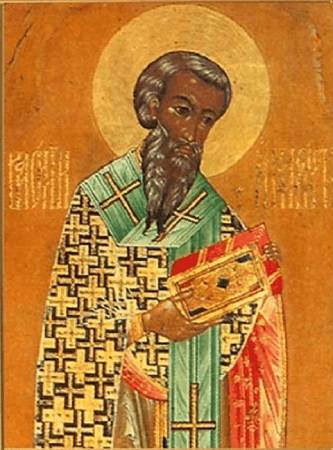
Calendar for May 9 His Homilist Basil of Amasia
Licinius, the son-in-law of Emperor Constantine, whose sister he had married,...
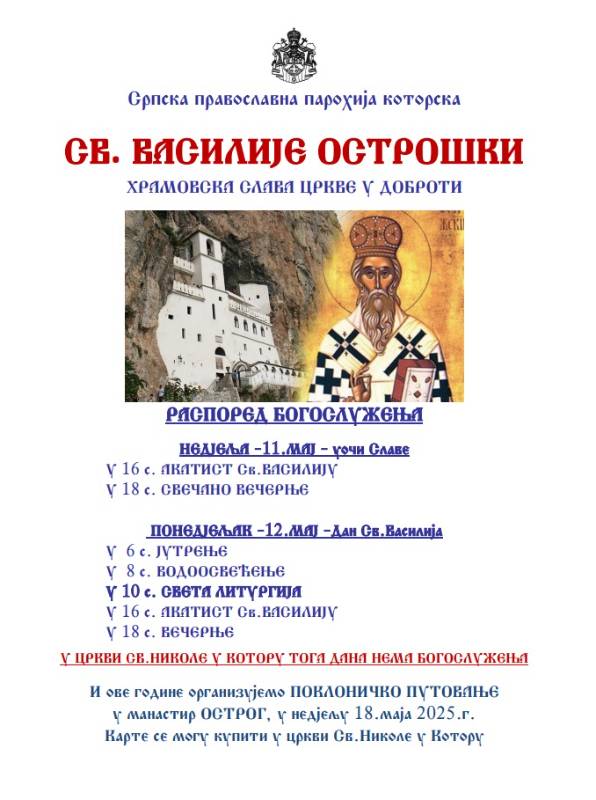
WORSHIPS ON THE OCCASION OF ST. VASILIJE OSTROŠKI
SERBIAN ORTHODOX PARISH OF KOTOR ANNOUNCES WORSHIPS ON THE OCCASION OF ST....
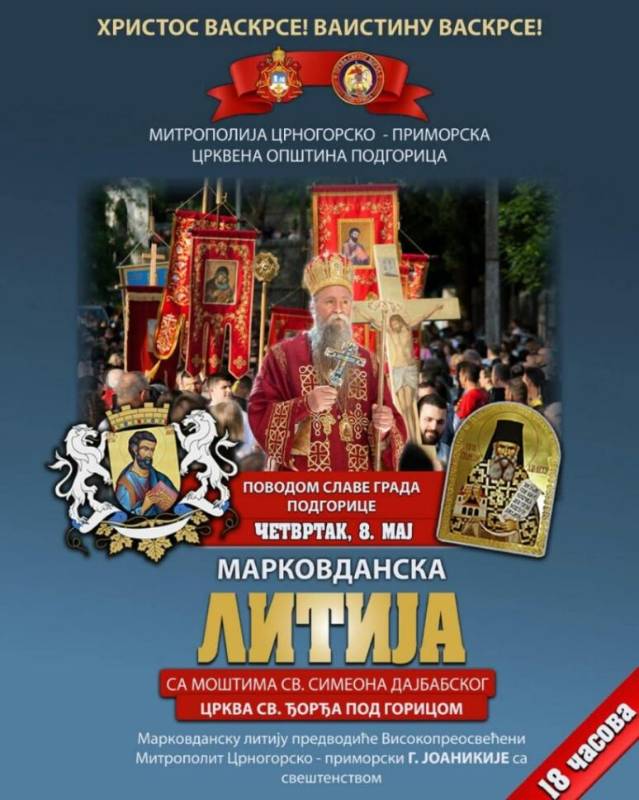
St. Mark's Day procession in Podgorica
On the occasion of the celebration of the city of Podgorica, the...


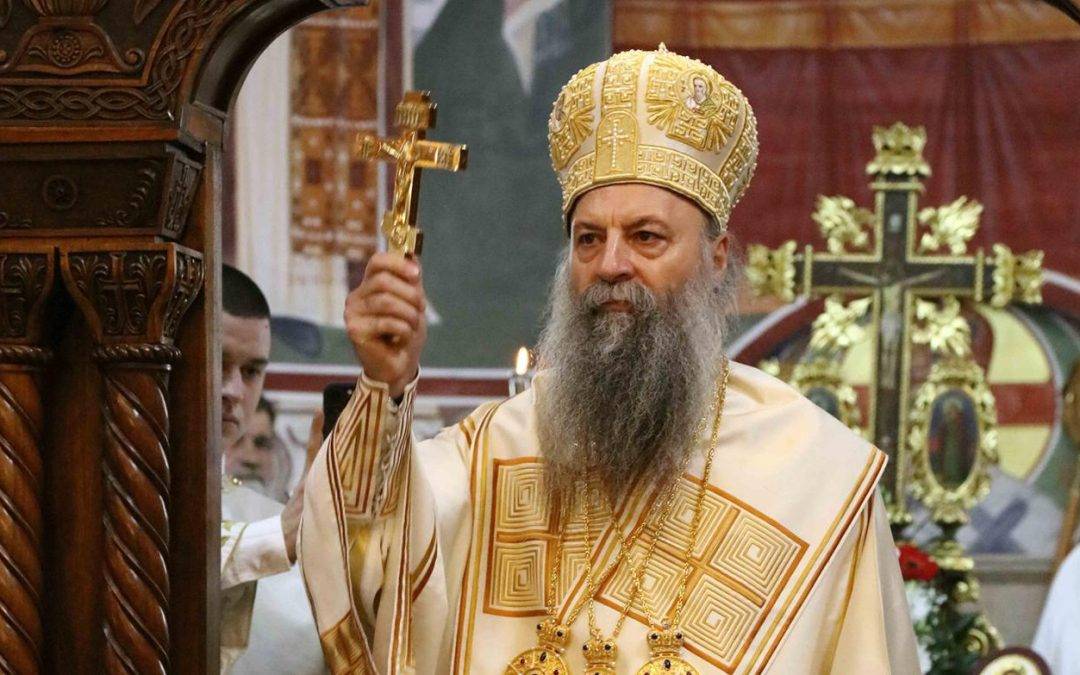

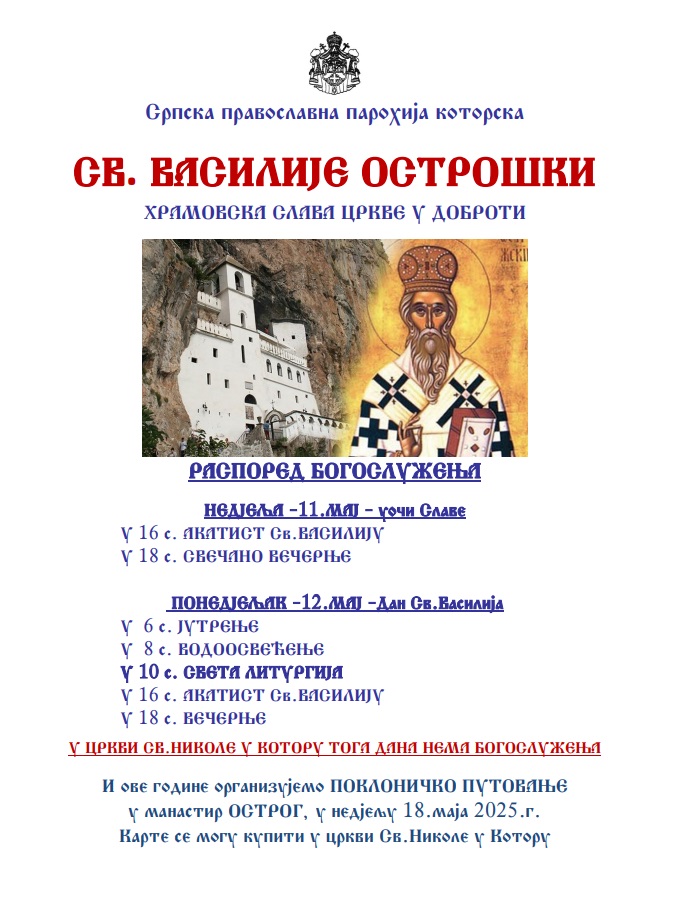
.png)